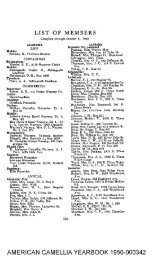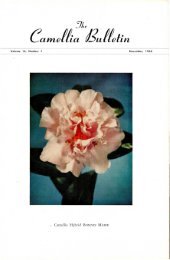CAMELLIA JAPONICA - GOVERNOR EARL WARREN - Immense ...
CAMELLIA JAPONICA - GOVERNOR EARL WARREN - Immense ...
CAMELLIA JAPONICA - GOVERNOR EARL WARREN - Immense ...
Create successful ePaper yourself
Turn your PDF publications into a flip-book with our unique Google optimized e-Paper software.
Northern California Camellia Society 5<br />
FOURTH ANNUAL CONVENTION of the AMERICAN <strong>CAMELLIA</strong> SOCIETY<br />
The Fourth Annual Convention of<br />
the American Camellia Society was<br />
held in Sacramento on March 4, 5<br />
and 6, 1949, in conjunction with the<br />
Silver Anniversary Camellia Show of<br />
the Camellia Society of Sacramento.<br />
New officers are Arthur W. Solomon<br />
of Savannah, Ga., president;<br />
William T. Wood of Macon, Ga., vice<br />
president for the Atlantic Coast; S.<br />
Katz of Covington, La., vice president<br />
for the Gulf Coast; and Dr. William<br />
Hertrich of San Marino, California,<br />
vice president for the Pacific Coast.<br />
Lafayette, La., was selected as the<br />
1950 convention city.<br />
On Saturday afternoon, March 5,<br />
an open meeting was held in the<br />
Little Theater in Memorial Auditorium.<br />
There was a panel discussion by<br />
State Directors on "Camellias, Happenings<br />
Here and There." It was<br />
brought out that in various sections<br />
of the United States, camellia plants<br />
had survived freezing weather, snow,<br />
and even flood conditions, indicating<br />
their hardiness.<br />
Roy J. Wilmot, Chairman, presented<br />
the Committee Report on Registration<br />
of New Varieties and Nomenclature<br />
Clearance. So far there have been<br />
five varieties registered and about<br />
eight more are in process of registration.<br />
It was agreed that registration<br />
should be simplified as much as possible;<br />
that any new seedling sent in<br />
should be registered.<br />
Over a period of years, Mr. Wilmot<br />
has collected camellia varietal names,<br />
including nursery catalogs dating<br />
back to 1821 and literature. To date,<br />
he has four or five thousand varietal<br />
names, each on a separate sheet, giving<br />
description and source of information.<br />
Mr. Wilmot then discussed "Classification<br />
of Camellia Blossoms by<br />
Structural Forms." Classifications<br />
based on similarity to other flower<br />
forms are confusing, he said. Anemone<br />
form. They don't grow anemones<br />
in the South. Rose form. What<br />
Rose? Dr. Hume decided to work out<br />
a classification based on structure of<br />
the flower.<br />
A flower is composed of petals,<br />
stamens, pistil, sepals, Mr. Wilmot<br />
explained. The simplest flower has<br />
one row of petal bracts around base<br />
forming sepals. As flower changes,<br />
it becomes more and more complicated.<br />
These petals break up into<br />
more and more petals. Some of the<br />
sepals form petals. Stamens turn into<br />
petals. And even the pistil may be<br />
transformed into petals. Hume followed<br />
that process through from the<br />
very simple flower to the very double<br />
flower and classified according to the<br />
amount of transformation that had<br />
taken place. (Hume's Classification<br />
was used in the 1949 Show of the<br />
N.C.C.S. Ed.)<br />
Mr. Wilmot emphasized that in recommending<br />
flower classification for<br />
any show the flower should be set<br />
up primarily by variety if there are<br />
enough entries of one variety. (In<br />
both the Sacramento and Berkeley<br />
shows, a separate class was set up<br />
where there were seven or more entries<br />
of one variety. Ed.)<br />
A. P. Messenger, Chief, Bureau of<br />
Plant Quarantine, California State Department<br />
of Agriculture, talked on<br />
"Exchanging Scions and Plants; What<br />
Not to Do." Mr. Messenger explained<br />
that he is the man who puts up the<br />
"Stop" sign, tells people from other<br />
states, "You can't send in a plant,"<br />
and tells Californians, "You can't<br />
have the plants."<br />
Mr. Messenger then told how one<br />
may ship plant material without tangling<br />
with his organization. First,<br />
don't bring in plants or scions that<br />
might have a pest on them because<br />
they will cause you a lot of trouble<br />
and may cause your neighbor a lot<br />
of trouble. The purpose of plant quarantine<br />
is to prevent the introduction<br />
of plant products that might do irreparable<br />
harm. All plant products<br />
must bear inspection upon arrival. If<br />
they are not so clean as the inspector




